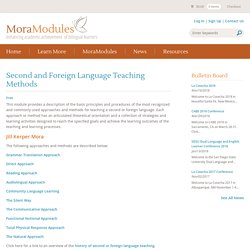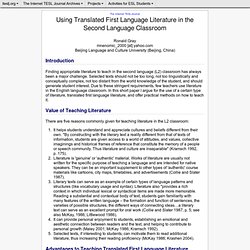

SLA%20Grammar%20Acquisition%20and%20Pedagogy. Principles of L2 Teaching Methods and Approaches. This module provides a description of the basic principles and procedures of the most recognized and commonly used approaches and methods for teaching a second or foreign language.

Each approach or method has an articulated theoretical orientation and a collection of strategies and learning activities designed to reach the specified goals and achieve the learning outcomes of the teaching and learning processes. Jill Kerper Mora The following approaches and methods are described below: Grammar-Translation Approach Direct Approach Reading Approach Audiolingual Approach Community Language Learning The Silent Way The Communicative Approach Functional Notional Approach Total Physical Response Approach The Natural Approach Click here for a link to an overview of the history of second or foreign language teaching.
Theoretical Orientations to L2 Methods & Approaches There are four general orientations among modern second-language methods and approaches: 1. 2. 3. 4. The Grammar-Translation Approach 1. 2. 3. Gray - Using Translated First Language Literature in the Second Language Classroom. The Internet TESLJournal Ronald Graymnenomic_2000 [at] yahoo.comBeijing Language and Culture University (Beijing, China) Introduction Finding appropriate literature to teach in the second language (L2) classroom has always been a major challenge.

Selected texts should not be too long, not too linguistically and conceptually complex, not too distant from the world knowledge of the student, and should generate student interest. Due to these stringent requirements, few teachers use literature in the English language classroom. In this short paper I argue for the use of a certain type of literature, translated first language literature, and offer practical methods on how to teach it. Value of Teaching Literature There are five reasons commonly given for teaching literature in the L2 classroom:It helps students understand and appreciate cultures and beliefs different from their own. Advantages to Teaching Translated First Language Literature Practical Classroom Implications Conclusion References. The influence of the mother tongue on second language vocabulary acquisition and use. (In Vocabulary: Description, Acquisition and Pedagogy, ed.

Schmitt and McCarthy, CUP 1997, pp. 156–180) 1 introduction "… contrastive analysis, error analysis, etc., are not simply unrelated to linguistic theory in particular, they are dead meat in general. " (Gregg 1995: 90, reviewing Cook 1993) Oh, well … In this paper I shall consider the ways in which the mother tongue can support, fail to support or actively hinder someone who is learning or using the vocabulary of a second language. "As a learning process, transfer supports the learner's selection and remodelling of input structures as he progresses in the development of his interlanguage knowledge. Before looking at these three areas, it will be useful to consider briefly how languages differ in the ways they encode the world through lexis, and to settle on a definition of crosslinguistic influence. 2 how languages differ "The vodka is all right, but the meat is bad.
" English French Danish Swedish tree wood (material) wood (small forest) bois. History of English Language Teaching. Dimitrios Thanasoulas Introduction The English language teaching tradition has been subject to tremendous change, especially throughout the twentieth century.

Perhaps more than any other discipline, this tradition has been practiced, in various adaptations, in language classrooms all around the world for centuries. While the teaching of Maths or Physics, that is, the methodology of teaching Maths or Physics, has, to a greater or lesser extent, remained the same, this is hardly the case with English or language teaching in general. As will become evident in this short paper, there are some milestones in the development of this tradition, which we will briefly touch upon, in an attempt to reveal the importance of research in the selection and implementation of the optimal methods and techniques for language teaching and learning.
Methodologies in Foreign Language Teaching.